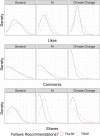Promoting engagement with quality communication in social media
- PMID: 36227911
- PMCID: PMC9560150
- DOI: 10.1371/journal.pone.0275534
Promoting engagement with quality communication in social media
Abstract
The COVID-19 pandemic made explicit the issues of communicating science in an information ecosystem dominated by social media platforms. One of the fundamental communication challenges of our time is to provide the public with reliable content and contrast misinformation. This paper investigates how social media can become an effective channel to promote engagement and (re)build trust. To measure the social response to quality communication, we conducted an experimental study to test a set of science communication recommendations on Facebook and Twitter. The experiment involved communication practitioners and social media managers from select countries in Europe, applying and testing such recommendations for five months. Here we analyse their feedback in terms of adoption and show that some differences emerge across platforms, topics, and recommendation categories. To evaluate these recommendations' effect on users, we measure their response to quality content, finding that the median engagement is generally higher, especially on Twitter. The results indicate that quality communication strategies may elicit positive feedback on social media. A data-driven and co-designed approach in developing counter-strategies is thus promising in tackling misinformation.
Conflict of interest statement
The authors have declared that no competing interests exist.
Figures






References
-
- Druckman JN, McGrath MC. The evidence for motivated reasoning in climate change preference formation. Nature Climate Change. 2019;9(2):111–119. doi: 10.1038/s41558-018-0360-1 - DOI
Publication types
MeSH terms
LinkOut - more resources
Full Text Sources
Medical

